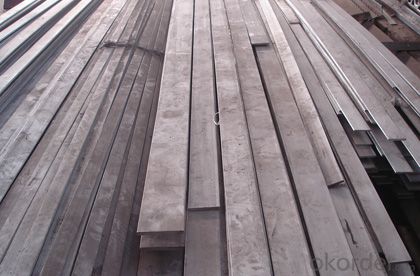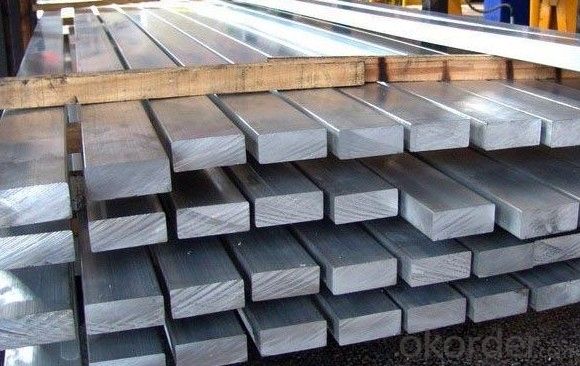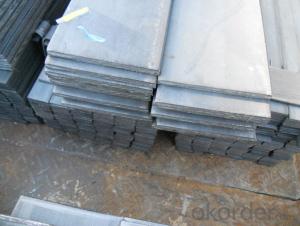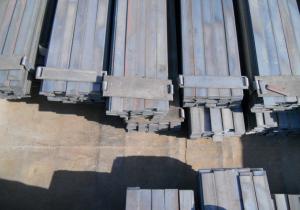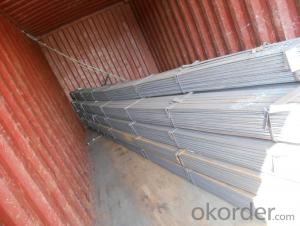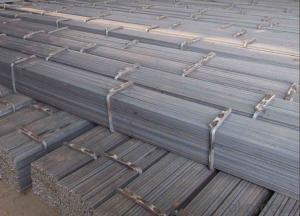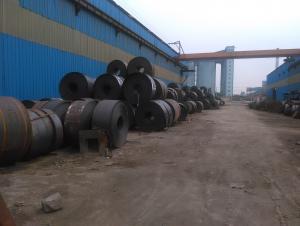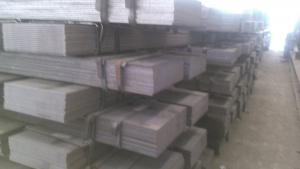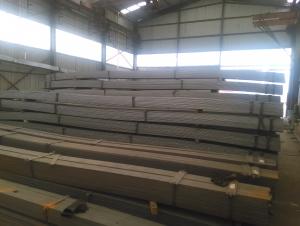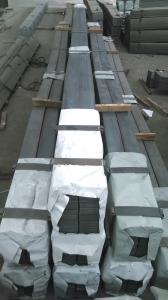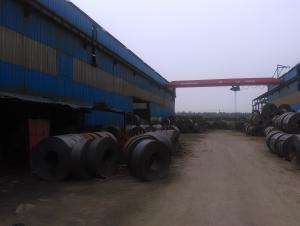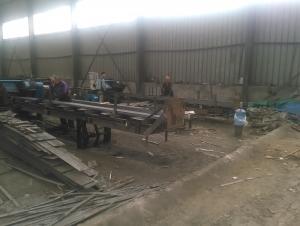Carbon steel flat bar in Grade Q235 for construction
- Loading Port:
- Tianjin
- Payment Terms:
- TT OR LC
- Min Order Qty:
- 10000 m.t.
- Supply Capability:
- 100000 m.t./month
OKorder Service Pledge
OKorder Financial Service
You Might Also Like
Product Description:
OKorder is offering carbon steel flat bar in Grade Q235 for construction at great prices with worldwide shipping. Our supplier is a world-class manufacturer of steel, with our products utilized the world over. OKorder annually supplies products to European, North American and Asian markets. We provide quotations within 24 hours of receiving an inquiry and guarantee competitive prices.
Product Applications:
Carbon steel flat bar are ideal for structural applications and are widely used in the construction of buildings and bridges, and the manufacturing, petrochemical, and transportation industries.
Product Advantages:
OKorder's Steel Flat Bar for construction are durable, strong, and resist corrosion.
Main Product Features:
· Premium quality
· Prompt delivery & seaworthy packing (30 days after receiving deposit)
· Corrosion resistance
· Can be recycled and reused
· Mill test certification
· Professional Service
· Competitive pricing
Product Specifications:
1. Size: 3*10mm~22*150mm
2. Material:Q195-235, SS400
3. factory direct sale
Size:3*10mm~22*150mm or as your requirment
Technics :hot rolled
Useage:used to make tools and machine parts, make room frame structure in construction
Falt steel bar is cross section for the rectangular with pure steel edge. The wide range is 12-300mm, thickness range is 4-60mm,It can be finished steel products, also can be used to do the blank pipe, roll thin with a thin slab, make tools and machine parts, make room frame structure in construction
FAQ:
Q3: How soon can we receive the product after purchase?
A3: Within three days of placing an order, we will begin production. The specific shipping date is dependent upon international and government factors, but is typically 7 to 10 workdays
Q5: Can stainless steel rust?
A5: Stainless does not "rust" as you think of regular steel rusting with a red oxide on the surface that flakes off. If you see red rust it is probably due to some iron particles that have contaminated the surface of the stainless steel and it is these iron particles that are rusting. Look at the source of the rusting and see if you can remove it from the surface.



- Q: How do steel flat bars perform in terms of fatigue resistance?
- Steel flat bars generally have good fatigue resistance due to their high strength and stiffness properties. They can withstand repeated loading and stress cycles without experiencing significant structural damage or failure. However, the specific fatigue performance of steel flat bars may vary depending on factors such as the steel grade, manufacturing process, surface finish, and design considerations.
- Q: Can steel flat bars be used for making brackets or supports for HVAC ductwork?
- Yes, steel flat bars can be used for making brackets or supports for HVAC ductwork. Steel flat bars are commonly utilized in construction and engineering projects due to their durability and strength. When used as brackets or supports for HVAC ductwork, steel flat bars provide stability and rigidity, ensuring that the ducts are securely held in place. Additionally, steel flat bars can be easily cut, shaped, and welded to meet specific requirements, making them a versatile choice for fabricating brackets or supports.
- Q: Are steel flat bars suitable for the construction of cultural or arts venues?
- The construction of cultural or arts venues can indeed make use of steel flat bars. Steel is a versatile and durable material with various architectural applications. It offers several advantages that make it an ideal option for cultural or arts venues. To begin with, steel flat bars provide excellent structural support. They possess high tensile strength and can bear heavy loads, making them suitable for constructing large and complex structures like theaters, concert halls, or art galleries. Steel's strength-to-weight ratio is also beneficial, allowing for the creation of spacious and open designs without compromising stability. Moreover, steel flat bars offer design flexibility. They can be easily shaped, bent, or welded to create intricate and artistic structures. This allows architects and designers to incorporate unique and visually appealing elements into their designs, enhancing the aesthetic appeal of cultural or arts venues. Additionally, steel is a sustainable building material. It is highly recyclable, and its production process consumes less energy compared to other construction materials. This makes steel flat bars an environmentally friendly choice, aligning with the growing emphasis on sustainable construction practices. Furthermore, steel's durability ensures that cultural or arts venues constructed with steel flat bars will have a long lifespan. Steel is resistant to corrosion, fire, and pests, reducing maintenance and repair costs over time. This durability makes it a reliable choice for venues that are expected to withstand heavy foot traffic and frequent usage. In conclusion, steel flat bars are indeed suitable for the construction of cultural or arts venues. Their strength, design flexibility, sustainability, and durability make them a popular choice among architects and developers. By utilizing steel, cultural or arts venues can be built to withstand the demands of artistic performances and exhibitions while also providing aesthetically pleasing and sustainable spaces for the public to enjoy.
- Q: Can steel flat bars be used in the manufacturing of fencing or gates?
- Absolutely, steel flat bars are ideal for incorporating into the production process of fencing or gates. Possessing remarkable strength and durability, steel flat bars emerge as an exceptional option for crafting robust fences and gates capable of enduring diverse weather conditions and ensuring security. By welding or bolting these bars together, a stable and enduring framework can be established, guaranteeing stability and durability. Moreover, steel flat bars can be effortlessly manipulated and tailored to meet precise design specifications, enabling the development of one-of-a-kind fences and gates that are visually appealing.
- Q: Are steel flat bars suitable for welding or fabrication?
- Yes, steel flat bars are suitable for welding or fabrication. Steel flat bars are commonly used in various industries, including construction, manufacturing, and transportation, due to their versatility and strength. They can be easily welded together to create larger structures or fabricated into different shapes and sizes to meet specific project requirements. Welding steel flat bars allows for the creation of strong and durable joints, making them suitable for applications that require structural integrity. Additionally, steel flat bars can be easily cut, drilled, and formed, making them a popular choice for fabricating a wide range of products.
- Q: Are steel flat bars suitable for automotive applications?
- Steel flat bars are indeed appropriate for automotive applications. Steel is a robust and resilient material that can endure the demanding requirements of the automotive sector. The versatility and simplicity of utilizing flat bars make them a common choice for automotive applications. They can be effortlessly customized, molded, and joined together to suit particular automotive components, thereby making them perfect for constructing frames, brackets, supports, and other structural elements. Furthermore, steel flat bars offer exceptional strength-to-weight ratio, corrosion resistance, and cost-effectiveness, rendering them highly favored in the automotive industry.
- Q: How to use -40*4 galvanized steel bar to do grounding electrode?
- The -40*4 galvanized flat steel is used as the grounding electrode, and the horizontal grounding electrode needs to be welded with the lead wire.
- Q: What are the standard packaging options for steel flat bars?
- The standard packaging options for steel flat bars typically include bundling them with steel straps or wrapping them in protective material such as plastic or paper, to ensure safe transportation and prevent damage or corrosion.
- Q: What are the common methods of surface treatment for steel flat bars?
- The common methods of surface treatment for steel flat bars include galvanizing, painting, powder coating, and hot-dip coating.
- Q: What is the difference between a steel flat bar and a steel square tube?
- A steel flat bar and a steel square tube are both forms of steel materials commonly used in construction and manufacturing. However, they differ in their shape and structural properties. The main difference lies in their cross-sectional shape. A steel flat bar has a rectangular shape with two flat parallel surfaces and straight edges, while a steel square tube has a hollow square shape with four equal sides and thicker walls. In terms of structural properties, a steel flat bar is typically used for its strength in resisting bending or flexing. It is often used as a support or reinforcement in construction projects, such as for framing or bracing purposes. On the other hand, a steel square tube offers greater strength and rigidity due to its hollow structure. It is commonly used as a structural component for load-bearing applications, such as in building frameworks, machinery, or in the manufacturing of furniture. Additionally, the manufacturing process for these two steel forms can differ. Steel flat bars are usually produced by hot rolling, which involves heating the steel billet and passing it through a series of rolling stands. This process results in a flat shape with smooth surfaces. In contrast, steel square tubes are typically manufactured through a process called electric resistance welding (ERW), where a flat strip of steel is formed into a tube shape and then welded along the edges. In summary, while both steel flat bars and steel square tubes are made of the same material, their shape and structural properties make them suitable for different applications. Steel flat bars are commonly used for support and reinforcement purposes, while steel square tubes are preferred for load-bearing applications due to their greater strength and rigidity.
Send your message to us
Carbon steel flat bar in Grade Q235 for construction
- Loading Port:
- Tianjin
- Payment Terms:
- TT OR LC
- Min Order Qty:
- 10000 m.t.
- Supply Capability:
- 100000 m.t./month
OKorder Service Pledge
OKorder Financial Service
Similar products
Hot products
Hot Searches
Related keywords





